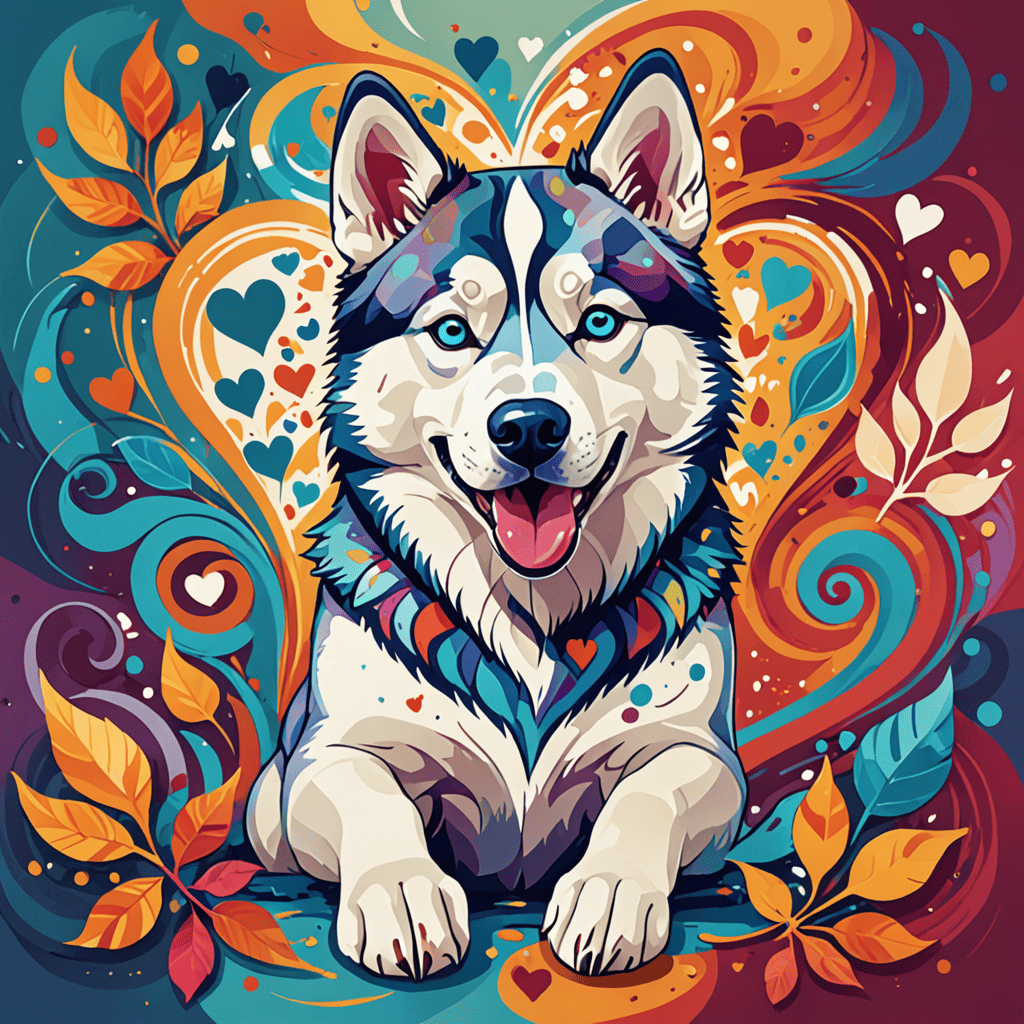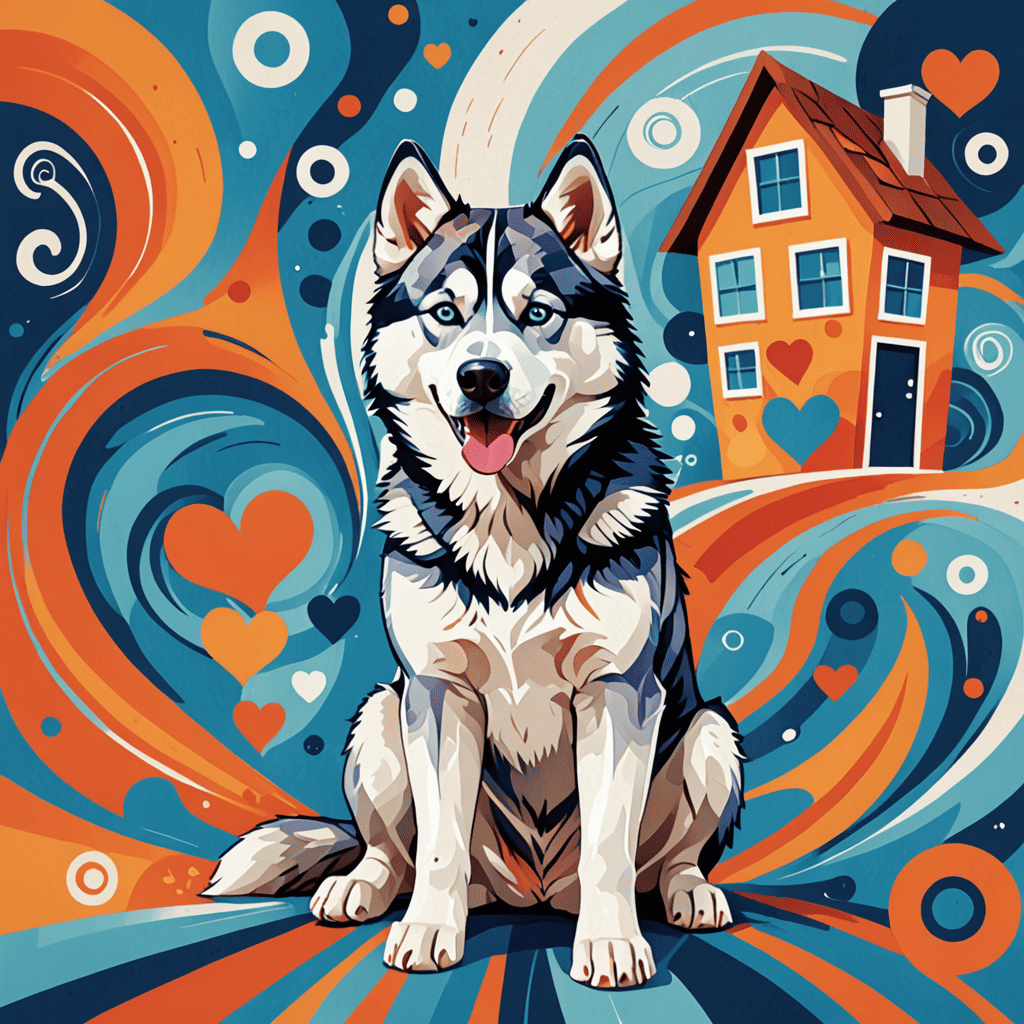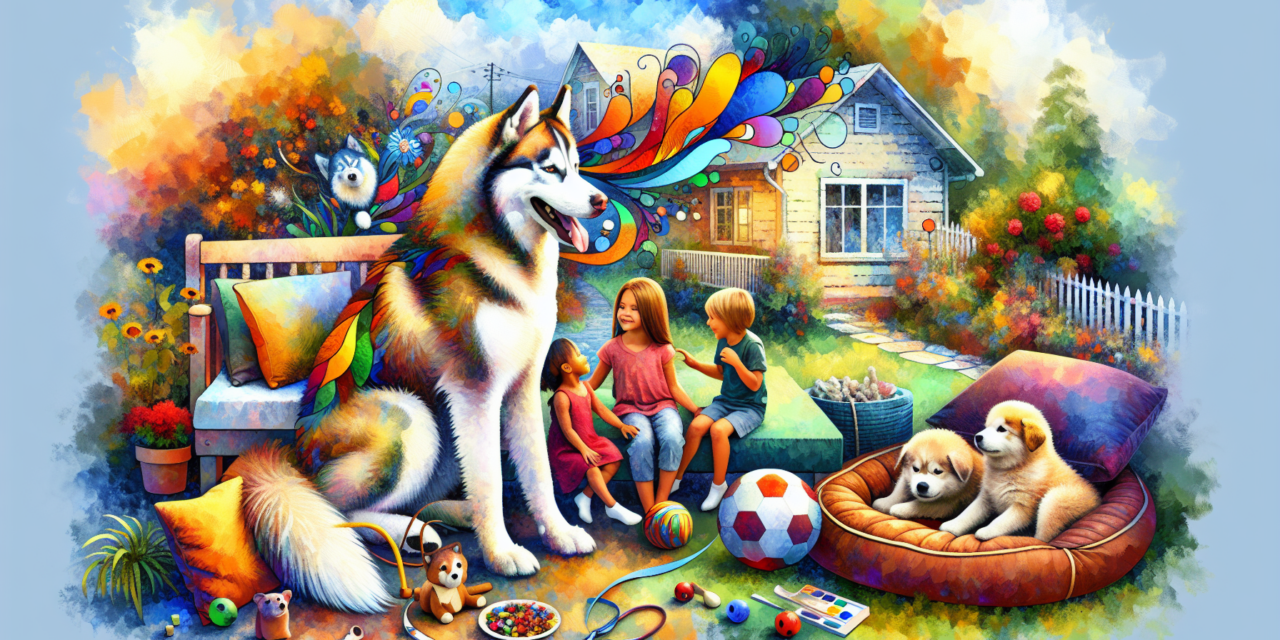Are you considering adding a husky dog to your family? This article will guide you through the essential insights on care, compatibility, and costs associated with owning a Siberian Husky. Known for their striking appearance and energetic nature, huskies can be wonderful family pets, but they also come with unique challenges. We will explore whether a husky is a good family dog by delving into their temperament and the benefits of ownership. Additionally, we will discuss common mistakes new husky owners make, training tips for a happy husky, and the social needs of these dogs. You’ll learn about adapting your home for a husky, the differences between Alaskan and Siberian huskies, and the cost considerations involved in husky ownership. By the end of this article, you will have a comprehensive understanding of whether a husky dog is the right fit for your family, ensuring you make an informed decision that aligns with your lifestyle.
Is A Husky a Good Family Dog?
Understanding the Siberian Husky Temperament
Huskies can be excellent family dogs, but there are several important factors to consider:
- Temperament: Siberian Huskies are known for their playful, friendly, and even-tempered nature. They typically get along well with children and other dogs, making them a sociable choice for families. However, their high energy levels mean they require regular exercise and mental stimulation.
- Energy Levels: Huskies are very energetic dogs that thrive on physical activity. They enjoy being around people and need daily exercise to prevent boredom, which can lead to destructive behaviors. Engaging in activities like running, hiking, or playing fetch can help channel their energy positively.
- Training Challenges: While Huskies are intelligent, they can be challenging to train, especially for inexperienced owners. Their independent nature and strong will can make obedience training difficult. Consistent, positive reinforcement methods are recommended, and early socialization is crucial to help them develop good manners.
- Size and Strength: As large and powerful dogs, Huskies may be too boisterous for very young children. Their playful nature can sometimes lead to accidental knocks, so supervision during playtime is essential.
- Grooming Needs: Huskies have a thick double coat that sheds heavily, particularly during seasonal changes. Regular grooming is necessary to manage shedding and maintain coat health. This can be a commitment for families, especially during shedding seasons.
- Health Considerations: Huskies can be prone to certain health issues, including cataracts, hip dysplasia, and progressive retinal atrophy. Regular veterinary check-ups and a healthy diet are important to ensure their well-being.
In summary, while Huskies can be wonderful family pets, they require an active lifestyle, consistent training, and proper grooming. Families considering a Husky should evaluate their ability to meet these needs to ensure a harmonious relationship. For more insights on pet care and family dynamics, resources like the American Kennel Club provide valuable information.
Benefits of Owning a Husky Dog
Owning a Husky comes with numerous benefits that can enhance family life:
- Companionship: Huskies are known for their loyalty and affectionate nature, making them great companions for both adults and children.
- Active Lifestyle: Having a Husky encourages families to engage in outdoor activities, promoting a healthier lifestyle through regular exercise.
- Social Interaction: Huskies are social dogs that often enjoy the company of other pets and people, which can help foster a sense of community.
- Intelligence: Their intelligence can be a double-edged sword, but it also means they can learn a variety of tricks and commands, providing mental stimulation for the dog and entertainment for the family.
- Unique Appearance: With their striking looks, Huskies often attract attention and admiration, making them a conversation starter in social settings.
In conclusion, while Huskies require commitment and effort, the rewards of companionship, an active lifestyle, and the joy they bring can make them a wonderful addition to any family. For more information on pet ownership and care, visit our blog for more insights.

What Not to Do to a Husky?
Owning a Siberian Husky can be a rewarding experience, but it also comes with its challenges. Understanding what not to do is crucial for ensuring your husky remains happy and healthy. Here are some common mistakes new husky owners make, along with essential training tips to foster a positive environment for your furry friend.
Common Mistakes New Husky Owners Make
Many first-time husky owners unknowingly make mistakes that can lead to behavioral issues or stress for their pets. Here are key pitfalls to avoid:
- Never Ignore Their Exercise Needs: Siberian Huskies are high-energy dogs that require substantial daily exercise. Failing to provide adequate physical activity can lead to behavioral issues such as excessive barking, digging, or destructive behavior. Aim for at least 1-2 hours of vigorous exercise daily, including activities like running, hiking, or engaging in dog sports (American Kennel Club).
- Avoid Punitive Training Methods: Huskies are intelligent and independent, which means they respond poorly to harsh training techniques. Instead, utilize positive reinforcement methods, such as treats and praise, to encourage good behavior. Research shows that positive reinforcement is more effective and fosters a stronger bond between you and your dog (The Humane Society).
- Do Not Keep Them Confined: Huskies thrive in open spaces and should not be kept in tight or confined areas for extended periods. If you live in an apartment, ensure you have access to nearby parks or open areas for regular exercise and socialization. Keeping them confined can lead to anxiety and escape attempts (PetMD).
- Never Skip Socialization: Early and ongoing socialization is crucial for Huskies to develop into well-adjusted adults. Expose them to various environments, people, and other animals to prevent fearfulness and aggression. Studies indicate that well-socialized dogs are less likely to exhibit behavioral problems (American Veterinary Medical Association).
- Avoid Overfeeding: Huskies are prone to obesity if overfed or given too many treats. Monitor their diet closely and provide balanced nutrition tailored to their activity level. Consult with a veterinarian to determine the appropriate feeding regimen and portion sizes (Association for Pet Obesity Prevention).
By adhering to these guidelines, you can ensure a happy and healthy life for your Siberian Husky, enhancing their well-being and strengthening your relationship.
Training Tips for a Happy Husky
Training your Siberian Husky effectively is essential for a harmonious household. Here are some tips to help you train your husky successfully:
- Start Early: Begin training your husky as soon as you bring them home. Early training helps establish good habits and prevents behavioral issues down the line.
- Be Consistent: Consistency is key in training. Use the same commands and rewards to reinforce desired behaviors, making it easier for your husky to understand what is expected.
- Incorporate Fun: Huskies are playful and intelligent. Incorporate games and fun activities into training sessions to keep them engaged and motivated.
- Socialize Regularly: Continue socializing your husky throughout their life. Regular interactions with other dogs and people will help them develop confidence and reduce anxiety.
- Seek Professional Help if Needed: If you encounter challenges in training, consider enrolling your husky in obedience classes or seeking guidance from a professional trainer experienced with the breed.
By following these training tips, you can cultivate a well-behaved and happy husky, ensuring a fulfilling companionship for years to come.
Can a Husky Be Left Alone?
Understanding whether a husky can be left alone is crucial for potential owners. Huskies are known for their high energy levels and social nature, making it challenging to leave them alone for extended periods. Here are key considerations regarding leaving a husky alone:
Social Needs of the Siberian Husky
Huskies are pack animals that thrive on companionship. Leaving them alone for long durations can lead to feelings of loneliness, resulting in anxiety and stress. This can manifest in destructive behaviors, such as chewing furniture or excessive barking. To ensure your husky remains happy and healthy, it’s essential to address their social needs effectively.
- Exercise Requirements: Huskies require significant physical activity—ideally, at least 1-2 hours of exercise daily. If left alone without adequate exercise, they may become restless and engage in undesirable behaviors. Consider incorporating activities like running, hiking, or interactive play before leaving them alone.
- Mental Stimulation: To prevent boredom, provide mental stimulation through puzzle toys, treat-dispensing toys, or training sessions. Engaging their minds can help reduce anxiety and keep them occupied while you are away.
- Gradual Acclimation: If you need to leave your husky alone, gradually acclimate them to being alone for short periods. Start with brief absences and gradually increase the duration to help them adjust.
- Companionship Options: If possible, consider hiring a dog walker or pet sitter to provide companionship and exercise during the day. Alternatively, having another pet can help alleviate loneliness.
- Professional Guidance: If your husky exhibits severe anxiety when left alone, consult with a veterinarian or a professional dog trainer. They can provide tailored strategies and support to address your dog’s specific needs.
In summary, while it is possible to leave a husky alone, it is crucial to consider their social and physical needs to ensure their well-being. For more information on dog behavior and training, resources like the American Kennel Club provide valuable insights.
Strategies for Managing Alone Time
To effectively manage the time your husky spends alone, implementing a few strategies can make a significant difference in their comfort and behavior:
- Structured Routine: Establish a consistent daily routine that includes exercise, feeding, and playtime. This predictability can help your husky feel more secure when you leave.
- Safe Space: Create a designated area in your home where your husky feels safe and comfortable. This could include their bed, favorite toys, and access to water.
- Interactive Toys: Invest in interactive toys that can keep your husky engaged while you are away. These toys can provide mental stimulation and help alleviate boredom.
- Short Departures: Practice leaving your husky alone for short periods and gradually increase the time as they become more comfortable. This helps them adjust to your absence without excessive anxiety.
- Technology Aids: Consider using pet cameras to monitor your husky while you are away. This can provide peace of mind and allow you to check in on them.
By implementing these strategies, you can help ensure that your husky remains happy and well-adjusted, even when left alone. For further insights on pet care, visit our blog for more tips and resources.
Can a Husky Be a House Dog?
Yes, a Siberian Husky can be a house dog, but there are important considerations to ensure their well-being. Here are key points to keep in mind:
- High Energy Levels: Huskies are known for their high energy and playful nature. They require at least 1-2 hours of vigorous exercise daily, including activities like running, hiking, or playing fetch. This helps prevent boredom and destructive behavior (American Kennel Club, 2021).
- Mental Stimulation: In addition to physical exercise, Huskies need mental challenges. Interactive toys, puzzle feeders, and training sessions can help keep their minds engaged. Incorporating obedience training can also strengthen your bond and provide structure (PetMD, 2022).
- Socialization: Early socialization is crucial for Huskies. Exposing them to various environments, people, and other animals helps them develop into well-rounded pets. Regular playdates or visits to dog parks can enhance their social skills (The Spruce Pets, 2023).
- Indoor Environment: While Huskies can adapt to indoor living, they thrive in homes with ample space to move around. Providing a designated area for them to relax and play indoors is beneficial. Ensure that your home is dog-proofed to prevent accidents (Cesar’s Way, 2022).
- Routine and Structure: Establishing a consistent daily routine that includes exercise, playtime, and training can help manage a Husky’s energy levels and behavior. This structure is essential for their happiness and can lead to a more harmonious household (Wellness Coaching For Life, 2023).
- Climate Considerations: Huskies have thick double coats designed for cold climates. If you live in a warmer area, ensure they have access to cool spaces and avoid excessive heat exposure, as they can be prone to overheating (VCA Animal Hospitals, 2021).
By addressing these needs, a Siberian Husky can thrive as a house dog, enjoying both indoor companionship and outdoor adventures.
Adapting Your Home for a Husky
To create a comfortable living environment for your Husky, consider the following adaptations:
- Space Management: Ensure your home has enough space for your Husky to move freely. Designate areas for play and rest, and consider using baby gates to manage their access to certain rooms.
- Dog-Proofing: Remove any hazardous items or toxic plants from your home. Huskies are curious and may chew on furniture or cords, so securing these items is essential.
- Comfortable Sleeping Area: Provide a cozy bed in a quiet spot where your Husky can retreat when they need rest. A comfortable sleeping area can help them feel secure and relaxed.
- Temperature Control: Ensure your home is well-ventilated and maintain a comfortable temperature, especially during warmer months. Fans or air conditioning can help keep your Husky cool.
Husky Dog Breeds: Indoor vs. Outdoor Living
When considering whether to keep a Husky indoors or outdoors, it’s essential to understand their needs:
- Indoor Living: Huskies can adapt well to indoor living if their exercise and mental stimulation needs are met. They thrive on companionship and should not be left alone for extended periods.
- Outdoor Living: While Huskies enjoy outdoor activities, they should not be kept outside all the time. They require human interaction and should be brought indoors, especially during extreme weather conditions.
- Balanced Approach: A combination of indoor and outdoor living is often ideal. Providing a secure outdoor space for play while allowing them to spend quality time indoors with the family can lead to a happy and healthy Husky.

Is Owning a Husky Difficult?
Owning a Siberian Husky can indeed be challenging for several reasons, primarily due to their unique characteristics and needs. Here are key factors to consider:
Challenges of Siberian Husky Ownership
- Exercise Requirements: Huskies are highly energetic dogs that require substantial daily exercise—typically at least 1-2 hours. This includes vigorous activities such as running, hiking, or engaging in dog sports. Without adequate physical stimulation, they may develop behavioral issues such as excessive barking or destructive tendencies (American Kennel Club, 2023).
- Socialization Needs: Huskies are social animals that thrive on interaction with both humans and other dogs. Early socialization is crucial to ensure they develop into well-rounded adults. Lack of socialization can lead to anxiety and aggression (The Humane Society, 2023).
- Shedding and Grooming: This breed is known for its thick double coat, which sheds heavily, particularly during seasonal changes. Regular grooming—at least once a week—is essential to manage shedding and maintain coat health. During shedding seasons, more frequent brushing may be necessary (PetMD, 2023).
- Vocalization: Huskies are known for their distinctive howls and vocalizations. While some owners appreciate this trait, it can be challenging for those living in close quarters or noise-sensitive environments. Training can help manage excessive vocalization (Cesar’s Way, 2023).
- Training Challenges: Huskies are intelligent but can be independent and stubborn. Consistent, positive reinforcement training methods are essential. Early obedience training can help mitigate behavioral issues and establish a strong bond between the owner and the dog (American Kennel Club, 2023).
- Health Considerations: Like all breeds, Huskies are prone to certain health issues, including hip dysplasia and eye conditions. Regular veterinary check-ups and a healthy diet are vital for their well-being (Veterinary Partner, 2023).
In summary, while owning a Siberian Husky can be rewarding, it requires a significant commitment of time, energy, and resources. Potential owners should carefully consider these factors and ensure they can meet the breed’s needs before bringing a Husky into their home.
Cost Considerations: Husky Price and Care
The financial aspect of owning a Husky is another critical consideration. The initial Husky price can vary significantly based on factors such as breeder reputation, location, and lineage. On average, you can expect to pay between $800 to $2,500 for a purebred Siberian Husky. However, this is just the beginning of your financial commitment.
Beyond the purchase price, ongoing costs include:
- Food: Huskies require high-quality dog food to meet their nutritional needs, which can cost between $50 to $100 per month.
- Grooming: Regular grooming sessions, especially during shedding seasons, can add to your expenses. Professional grooming can range from $30 to $100 per session.
- Veterinary Care: Routine check-ups, vaccinations, and potential health issues can lead to annual costs of $300 to $600 or more.
- Training: Investing in obedience training classes can help mitigate behavioral challenges and typically costs around $150 to $300 for a series of sessions.
In conclusion, while the joy of owning a Husky is immense, it is essential to be prepared for the financial responsibilities that come with it. Understanding the Husky price and ongoing care costs will help ensure a fulfilling experience for both you and your furry companion.
Do Huskies Like to Sleep with Their Owners?
Understanding the Bond Between Huskies and Their Owners
Huskies are known for their strong pack mentality, and sleeping close to their owners enhances this bond. This behavior is rooted in their ancestry as sled dogs, where close proximity to their pack provided warmth and security. The emotional connection formed during these moments can significantly strengthen the relationship between a husky and its owner.
According to a study published in the Journal of Veterinary Behavior, dogs that sleep close to their owners exhibit lower stress levels and improved sleep quality, as they feel protected and secure in their environment. This sense of security is vital for huskies, who thrive on companionship and social interaction.
Sleeping Arrangements for Your Husky
While many huskies enjoy snuggling with their owners, individual personalities play a significant role in their sleeping preferences. Some huskies may prefer their own space due to their independent nature. Factors such as age, past experiences, and socialization can influence these preferences.
Proper training and socialization from a young age can significantly affect a husky’s desire to sleep with their owner. Positive reinforcement techniques can encourage closeness, while a lack of socialization may lead to a more independent sleeping style. Resources like Wellness Coaching For Life emphasize the importance of understanding your dog’s behavior and needs to foster a healthy relationship.
It’s also essential to consider the health of both the husky and the owner. If the husky has any health issues or if the owner has allergies, it may be better for them to have separate sleeping arrangements. Regular veterinary check-ups can help ensure that both parties are healthy and comfortable.
In conclusion, while many huskies enjoy sleeping with their owners due to the bonding experience and sense of security it provides, individual preferences and proper training play crucial roles in this behavior. Understanding these factors can enhance the relationship between huskies and their owners, leading to a happier and healthier coexistence.
Exploring the Alaskan Husky vs. Siberian Husky
When considering a husky dog, understanding the differences between the Alaskan Husky and the Siberian Husky is crucial. Both breeds share a common ancestry and exhibit similar physical traits, but they serve different purposes and have distinct temperaments.
Key Differences Between Husky Dog Breeds
The Alaskan Husky is primarily bred for performance and endurance, often used in sled racing and other working roles. They are not recognized as a specific breed by the American Kennel Club (AKC) but are a mix of various breeds, including Siberian Huskies, hounds, and other working dogs. This breed tends to be more variable in appearance and temperament, often showcasing a range of colors and sizes.
In contrast, the Siberian Husky is a purebred dog known for its striking blue or multi-colored eyes and thick double coat. Recognized by the AKC, Siberian Huskies are friendly, energetic, and known for their playful nature. They were originally bred by the Chukchi people of Siberia for companionship and as sled dogs, which contributes to their sociable demeanor.
In summary, while both breeds are excellent companions, the Alaskan Husky is more performance-oriented, whereas the Siberian Husky is recognized for its friendly temperament and striking appearance. Understanding these differences can help potential owners choose the right breed for their lifestyle.
Choosing the Right Husky for Your Family
When selecting between an Alaskan Husky and a Siberian Husky, consider your family’s lifestyle and activity level. If you lead an active life and enjoy outdoor activities, an Alaskan Husky may be a suitable choice due to their high energy and endurance. However, if you prefer a dog that is more sociable and adaptable to family life, the Siberian Husky might be the better option.
Additionally, consider the husky price, as it can vary significantly between the two breeds. Siberian Huskies typically have a higher price point due to their purebred status and popularity. It’s essential to factor in not just the initial cost but also ongoing expenses such as food, grooming, and veterinary care.
Ultimately, the decision should align with your family’s needs and lifestyle, ensuring a harmonious relationship with your new husky dog.












